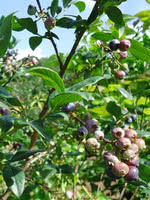Mon-Fri 9am - 5pm Mountain time
Blue Crop Blueberry vs Bilberry
Vaccinium myrtillus
Vaccinium corymbosum Blue Crop
CUSTOM GROW
NOT AVAILABLE THIS SEASON - MIGHT RETURN
Bilberry is a native perennial shrub valued for its small, blue-black berries that ripen in mid to late summer. The berries resemble blueberries but have a richer, more tart, and intense flavor. They have long been used for fresh eating, baking, and preserves, while also providing food for birds and mammals. In spring, its delicate pinkish flowers attract bees and other pollinators.
Growing low to the ground, Bilberry forms spreading colonies that create dense understory cover. This growth habit provides food and shelter for wildlife, and its foliage adds seasonal interest by turning red to purple in autumn. With its adaptability and ecological benefits, Bilberry is well-suited for naturalization, ecological restoration, and pollinator gardens.
Blue Crop Blueberry is a high yielding, commercial highbush blueberry variety that is widely planted. If you're lucky enough to live in a suitable climate zone, Blue Crop Blueberry is a great choice. Its very large berries taste amazing. They are very firm and store well.
While this variety is self-pollinating, we recommend pairing Blue Crop Blueberry with another Blueberry to increase the berry production of both varieties.
You must prune Blue Crop Blueberry to maintain its health and productivity.
Note: Blueberries require very specific soil conditions. They need well-drained soil with a pH between 4.5 and 5.0.
Bilberry Quick Facts
Blue Crop Blueberry Quick Facts
Toxicity: leaves may be unsafe in high doses

